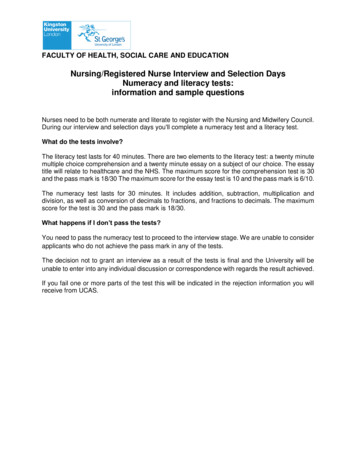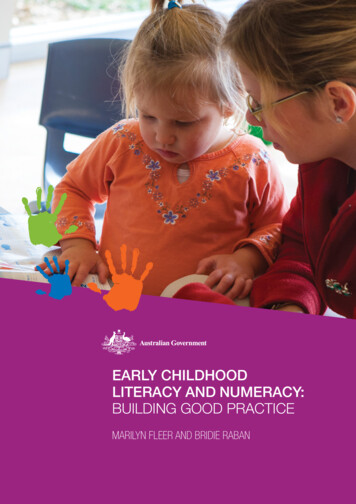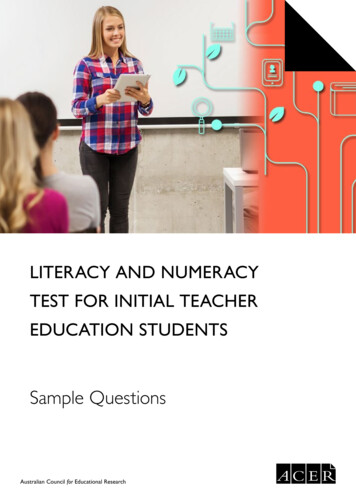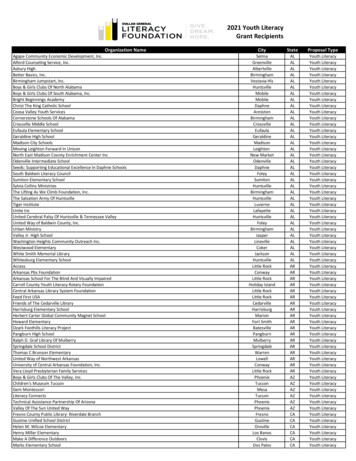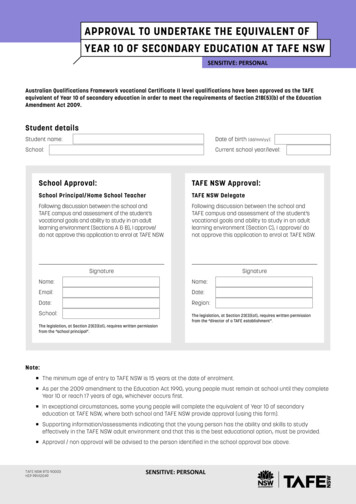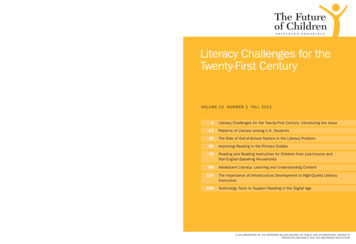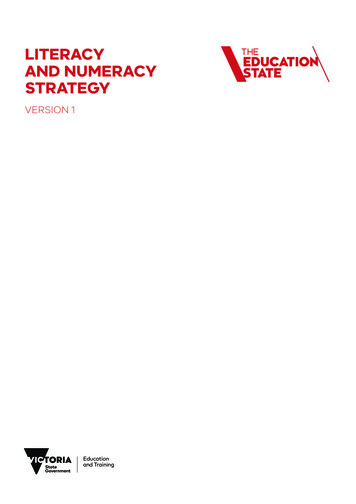
Transcription
LITERACYAND NUMERACYSTRATEGYVERSION 1
Published by the Department of Education and TrainingMelbourne June 2017 State of Victoria (Department of Education and Training) 2017The copyright in this document is owned by the Stateof Victoria (Department of Education and Training),or in the case of some materials, by third parties (thirdparty materials). No part may be reproduced by anyprocess except in accordance with the provisions of theCopyright Act 1968, the National Education Access Licencefor Schools (NEALS) (see below), or with permission.An educational institution situated in Australia whichis not conducted for profit, or a body responsiblefor administering such an institution may copy andcommunicate the materials, other than third partymaterials, for the educational purposes of the institution.Authorised by the Department of Education and Training,2 Treasury Place, East Melbourne, Victoria, 3002.ISBN: 978-0-7594-0800-52 The Education State
ContentsSecretary’s Foreword 5Why literacy and numeracy? 6Literacy and numeracy in the Education State8Why now? 10What is the Literacy and Numeracy Strategy?12Principles and expectations 12Timelines 14Strategic focus and summary of actions18Support for our teachers20Support for all 20Additional support for selected schoolsSupport for our school leaders2324Support for all 24Additional support for selected schools24Implementation and impact 26Shaping the strategy 27Literacy and Numeracy Strategy: Version 1 3
4 The Education State
Secretary’sForewordIt gives me great pleasure to introduce the EducationState: Literacy and Numeracy Strategy. This Strategyhas been developed to respond to your needs, andat the request of the Minister for Education, The Hon.James Merlino, MP.excellence in teaching and learning. These strategiesare recognisable, key instructional practices usedin every day teaching, which will support strongeroutcomes across all learning areas, including literacyand numeracy.Across Victoria, you have been working hard to lift theliteracy and numeracy achievement of the children andyoung people in your classrooms and communities. Yourexcellent results are making a real difference to theirlives.This Strategy sets out how system-wide success inliteracy and numeracy will come from fully drawing onour existing Education State foundations including theFISO. This means having a strong focus on literacy andnumeracy at all levels of the system; delivery of detailedinformation and guides for schools and teachers tohelp them assess and teach most effectively; andadditional support tailored to school need.As you know, literacy and numeracy are foundationalto engagement in education and lifelong achievement.Strong literacy and numeracy help us to learn,experiment, reason and create, to be active andinformed citizens, and to contribute socially, culturallyand economically.Our understanding of, and the demands of, literacyand numeracy teaching and learning are greater todaythan ever before. Success in literacy and numeracyfor our students involves creating, interpreting andcommunicating. It also requires understanding,reasoning, authentic problem-solving and buildingresilience and persistence.Our collective challenge is to ensure that every studentin Victoria is able to benefit from this focused effort. Wewant all of our young people to reach their full potential,including in literacy and numeracy. This means lifting asan entire system.In every classroom, in every school, every teacher andevery principal has a role to play in this Strategy.So too do networks, regions and central office.We will work together to join the system up to supportyou. This is what it will take to lift outcomes for everystudent.We know this is possible from looking at successfullocal and international examples. And we know we havesignificant strengths in our system to build on,as articulated by people at every level of that system.You have told us that to help you in your work with all ofyour students, you want easily accessible, high quality,and differentiated literacy and numeracy support.This includes the provision of evidence-based, detailedguidance on literacy and numeracy leadership andteaching. This is why we are introducing the Excellencein Teaching and Learning: A School Leaders’ Guide toImproving Literacy and Numeracy Outcomes. Detailedbut not prescriptive, the Guide sets out the structures,processes, and deliberative practices that have alreadybeen shown to work in Victoria and elsewhere to liftliteracy and numeracy outcomes.The Strategy is all about bringing together the abilityto assess students’ progress with evidence-basedteaching and whole-school actions. Through thePanorama reports and other school-based data,we now have the capacity to work out where students,classes and schools can improve.There are children and young people in classrooms andschools across Victoria who urgently need us to worktogether more effectively to support their literacy andnumeracy learning. For them, the window to realisingtheir full potential is either opening or closing, right now.I commit that as part of this Strategy we will maintainthis sense of urgency. We will draw on and learn fromthe great work that is already happening in Victoria andelsewhere. We will continue to refine this Strategy anddevelop its implementation with you. And we will keepbringing ourselves back to the critical question: whatcan we each do to make the biggest difference to thelearning of children and young people?We will develop and implement this strategy with you.The support outlined in this document will be testedin practice – through engagement forums, networks,and regional teams. Your ideas and knowledge willshape both the implementation and further iterationsof the Strategy. I thank you for your professionalism andyour hard work.I am pleased to be able to offer you this strategicapproach to literacy and numeracy to accelerate thework we are all doing for the benefit of Victorian childrenand young people.Gill CallisterSecretaryFor leaders and teachers, we are also providingHigh Impact Teaching Strategies - to further supportLiteracy and Numeracy Strategy: Version 1 5
Why literacyand numeracy?A strong foundation in literacy and numeracy is vital forevery child and young person, and underpins their abilityto engage in education, reach their potential, and toparticipate fully in the community. This contributes to avirtuous circle, in which characteristics such as the abilityto reason critically, to experiment, and to be resilient andpersistent also support the development of literacy andnumeracy.Children and young people need increasinglysophisticated levels of language and mathematics in orderto take care of their health and wellbeing, participatein the workforce and make a positive contribution to ademocratic society. Mathematics supports us to analyseand reason about the nature of the world. Languageenables us to communicate effectively, which is vital tofeeling connected to the people around us.This is why strong literacy and numeracy outcomes for allchildren and young people are a key part of the EducationState goals and targets, including Learning for life andBreaking the link, alongside and supporting Happy,healthy and resilient kids and Pride and confidence inour schools. In the Education State, we care deeply aboutliteracy and numeracy, but we don’t care only aboutliteracy and numeracy.Literacy and numeracy underpin the acquisition of morecomplex skills. For example, making the transition from‘learning to read’ to ‘reading to learn’ provides childrenwith opportunities to engage with the entire schoolcurriculum, including critical and creative thinking, socialsciences, STEM subjects (science, technology, engineeringand mathematics) and the arts. This is also the case forchildren who make the transition from ‘learning to write’to ‘writing for academic success’. An understandingof numbers and a robust knowledge of mathematicalconcepts enables children and young people to makeconnections between related ideas and to progressivelyapply their understanding in new and unfamiliar contexts.More studentsexcel in the artsMore studentsexcel in readingand mathematicsMore studentsdevelop strongcritical and creativethinking skillsMorestudentsexcel inscientificliteracyMore studentswill be resilientMorestudents stayin educationfor betterpathwaysLEARNINGFOR LIFEBREAKINGTHE LINKHAPPY,HEALTHY &RESILIENTKIDSMore studentswill be physicallyactive6 The Education StatePRIDE &CONFIDENCEIN OURSCHOOLSRaise the levels ofcommunity pride andconfidence in Victoriangovernment schoolsReduce theimpact ofdisadvantageAs young people enter high school, they need to developmore specific literacy and numeracy capabilities so thatthey can access the curriculum across the disciplines theystudy.We all know that there is a world of difference betweenthe life and prospects of a student who is not meetingminimum standards, a student who is in the lowestbands of NAPLAN, and a student who is in the top twobands. Strong literacy and numeracy supports studentengagement and achievement, completion of Year 12 andtertiary education, and employment and higher income –all of which are also associated with better health and lessinvolvement with the justice system.Today, more than ever before, the consequences of nothaving strong literacy and numeracy are substantial. Theability to tell opinion from fact, to understand a changingenvironment, to connect with others within and beyondour community, and to do meaningful work in a global andincreasingly automated economy – all require a citizenrywith higher levels of literacy and numeracy.
That’s why, as part of a suite of holistic targets, we havecommitted to ambitious literacy and numeracy targets aspart of the Education State reforms: 25 per cent more Year 5 students will reach the highestlevels of achievement in reading and maths by 2020; 25 per cent more Year 9 students will reach the highestlevels of achievement in reading and maths by 2025;and a 15 per cent reduction in the gap in averageachievement between disadvantaged and otherstudents in Year 5 and Year 9 reading by 2025.We know that lifting literacy and numeracy achievementacross our system is possible, based on past experiencehere in Victoria, and internationally. Analysis ofProgramme for International Student Assessment (PISA)results suggests that a number of jurisdictions havesuccessfully ‘raised the bar and closed the gap’ in learningoutcomes. Students in places such as Canada, Hong Kong,Ireland, Japan, Korea and New Zealand, for example,have achieved a significant improvement in their readingoutcomes between 2009 and 2015, compared to Australia’sresults over the same period. Other jurisdictions suchas Singapore, France, Norway and Germany havesignificantly improved their percentage of students in thetop two performance bands during this time.Literacy is defined as students’ ability to interpretand create texts with appropriateness, accuracy,confidence, fluency and efficacy for learning in andout of school, and for participating in the workplaceand community. Texts include media texts, everydaytexts and workplace texts from increasingly complexand unfamiliar settings, ranging from the everydaylanguage of personal experience to more abstract,specialised and technical language, including thelanguage of schooling and academic study. Studentslearn to adapt language to meet the demands of moregeneral or more specialised purposes, audiences andcontexts. They learn about the different ways in whichknowledge and opinion are represented and developedin texts, and about how more or less abstraction andcomplexity can be shown through language andthrough multimodal representations. This meansthat print and digital contexts are included, andthat listening, viewing, reading, speaking, writingand creating are all developed systematically andconcurrently (VCAA, 2017).Numeracy is the knowledge, skills, behavioursand dispositions that students need in order touse mathematics in a wide range of situations. Itinvolves recognising and understanding the role ofmathematics in the world and having the dispositionsand capacities to use mathematical knowledgeand skills purposefully. Number, measurement andgeometry, statistics and probability are commonaspects of most people’s mathematical experiencein everyday personal, study and work situations.Equally important are the essential roles thatalgebra, functions and relations, logic, mathematicalstructure and working mathematically play in people’sunderstanding of the natural and human worlds,and the interaction between them. Students areexposed to increasingly sophisticated and refinedmathematical understanding, fluency, reasoning,modelling and problem-solving. These capabilitiesenable students to respond to familiar and unfamiliarsituations by employing mathematics to makeinformed decisions and solve problems efficiently.There is now also good evidence that other areas ofdevelopment – such as resilience and perseverance– support achievement in numeracy as well (VCAA,2017).Literacy and Numeracy Strategy: Version 1 7
Literacy and numeracyin the Education StateIn September 2015, the Minister for Education, the Hon.James Merlino MP, launched the Education State: Schoolsagenda. This comprehensive reform agenda includesrecord investment in equity funding with the aim ofbuilding an education system that produces excellenceand reduces the impact of disadvantage.Excellence and equity are the twin pillars of the schoolsreform agenda. Through these reforms, we have launcheda suite of initiatives including: the Victorian Curriculum,200 Primary Mathematics and Science Specialists,LOOKOUT, Navigator, and leadership programs foremerging leaders, aspiring principals and system leaders.Each of the initiatives is based on evidence and hasbeen designed to support you to deliver better teaching,stronger leadership, and increased support for every childand young person in Victoria. The extra support beingprovided to principals and school communities throughrevitalised Regions and Areas signals the importance ofcollaboration and collective responsibility for all students.The current FISO focus on Excellence in teaching andlearning is already well underway through schoolAnnual Implementation Planning, Area Principal Forums,Communities of Practice and the Regional PrincipalForums. To support these efforts, and in response to yourfeedback, we are introducing this Literacy and NumeracyStrategy to support you: principals, school improvementteams, teachers, and education support staff.The Strategy outlines the ways in which key features ofthe system will work together within the FISO structureto support teachers to engage in high quality teachingand learning practices, enabled by quality professionalleadership.To support Excellence in Teaching and Learning andProfessional Leadership in literacy and numeracy,this Strategy provides: school leaders with access to high quality datasets and professional development to assessschool and student achievement – so youcan understand and diagnose your school’sperformance, as the basis for formulatingapproaches to strengthening practice; school leaders with clear, detailed guidance onactions that improve literacy and numeracyperformance (where needed) within the FISOimprovement cycle; teachers with high quality, evidence-basedguides and professional learning - to informpractice across curriculum, pedagogy, andassessment (including formative assessment); teachers and schools with support for allchildren and young people to succeed in literacyand numeracy; teachers with support to work as researchers oftheir own practice, and in a collaborative way; schools and teachers with support andencouragement to learn from each other; and differentiated support for all schools to lift theirperformance.The Education State school targets are ambitious. Theyacknowledge the learning and development of the ‘wholechild’ and the knowledge, skills and dispositions thatchildren and young people need to thrive today and intothe future.The Framework for Improving Student Outcomes (FISO)was introduced to provide a common language acrossour system to facilitate collaboration and the adoptionof evidence-based strategies to lift student achievementacross the State. In addition, it supports you to plan howto allocate Education State school funding to get the bestresults for your school, and to lift student achievement.Since the commencement of the Education State reforms,together we have made significant progress by workingcollaboratively at each level of the system to bring aboutimprovement. Building on the strengths in our system andthe momentum achieved through initiatives, we are wellpositioned to sharpen our focus and to work with greaterprecision on ensuring consistent quality of teaching andlearning in all classrooms and schools. We know that youare capable and caring professionals, who want to supportand strengthen a culture of continuous improvement inteaching and learning throughout our system.8 The Education State
Excellence in teaching and learningBuilding practiceexcellenceExcellence inteachingand learningEvidence-basedhigh impactteaching strategiesEvaluatingimpact onlearningStudentachievement,engagementand wellbeingycleent CvemproImTeachingStrategiesCurriculumplanning andassessmentSOFIEach of theinitiatives is basedon evidence andhas been designedto support youto deliver betterteaching, strongerleadership, andincreased supportfor every child andyoung person inVictoria.Evidence-Based HighImpact Teaching StrategiesCurriculum Planning and AssessmentBuilding Practice ExcellenceEvaluating Impact on LearningEmpowering studentsand building school prideHealth and wellbeingGlobal citizenshipNetworks with schools,services and agenciesProfessionalleadershipSetting expectationsand promoting inclusionParents and carersas partnersCommunityengagementin learningPositiveclimate nt andself awarenessBuilding leadershipteamsVision, valuesand cultureInstructionaland rk for ImprovingStudent Outcomes (FISO)Literacy and Numeracy Strategy: Version 1 9
Why now?There are two key reasons why we are now deepening ourfocus on literacy and numeracy achievement, drawingon the strengths in our schools, and building on thefoundational Education State reforms.First, while many of our children and young people areachieving well in literacy and numeracy, a significantgroup are not reaching their full potential.PISA data indicates that, compared to the best performingcountries, Victoria has fewer students performing at thehighest levels of proficiency and more students who arenot meeting the minimum standards. On average, arounda third of high performing students in government primaryand secondary schools are not maintaining their highlevel NAPLAN performance (top 2 bands) from one testingperiod to the next (e.g. Year 3 to Year 5, Year 7 to 9).PISA data also indicates that the average reading literacyof Victorian students is significantly lower than in the bestperforming jurisdictions overseas. The reading literacyof Victorian students aged 15 years is, on average, morethan half a year behind their counterparts in Singapore,Hong Kong, Canada, and Finland. Compared to the bestperforming jurisdictions, Victoria has fewer studentsperforming at the highest levels of proficiency (10 percent) and more students who are performing belowstandard (16 per cent).10 The Education StateA pressing and persistent challenge is the variation inoutcomes between students from disadvantaged familiesand those from higher socio–economic backgrounds.Grattan Institute analysis of Victorian NAPLAN data hasfound that the gap in achievement between studentswhose parents have low education and those with highlyeducated parents grows from 10 months in Year 3 toaround two-and-a-half years by Year 9. Even if they weredoing as well as their peers in Year 3, disadvantagedstudents make one to two years less progress by Year9 than students whose parents have more education.Importantly, the learning gaps grow much larger after Year3. Disadvantaged students are falling further behind eachyear they are at school.Encouragingly, we know that in every region of Victoria,there are examples of schools in low socioeconomic areasthat are already successfully breaking the link betweendisadvantage and achievement. It is important that welearn from this great work.We also know that low achievement is not restricted todisadvantaged students. More than half of the studentsnot meeting the minimum standards in Victoriangovernment schools are not in commonly identifieddisadvantaged cohorts (low socioeconomic status,Indigenous background, refugee background, andstudents with a disability). Rather, there are challenges forevery school and every teacher in supporting all studentsto succeed in literacy and numeracy.
Analysis of PISA data suggests that significant gains inthe top two levels of achievement are correlated withgains in the lower bands, so the focus on educationalachievement in the classroom will have a positiveimpact for all students. A sharper focus on educationachievement in the classroom will help reduce theachievement gap between students from disadvantagedbackgrounds and other students, assisting us to achievethe Education State Breaking the link targets.Second – and critically – we are ready to take thisstep. We have strong foundations on which to build.We have worked together to develop and put in placethe Education State reforms. This includes the FISO,Communities of Practice, significant additional equityfunding, more support for schools through the LearningPlaces model, the Victorian Curriculum, the InsightAssessment Platform and Panorama. We have alsoworked with the Aboriginal community to develop theMarrung Aboriginal Education Plan to support Victoriato be a place where the rich and thriving culture, andbroader knowledge and experience of our First NationsPeoples are celebrated by all Victorians, and where ourservice systems are inclusive and Koorie learners achievetheir potential. Having these foundations in place willmake a critical difference to the success of our combinedefforts to lift literacy and numeracy achievement acrossour system. With a shared sense of urgency aboutthe importance of this task for our students, and theadditional supports set out in this Strategy, we cansupport all our students to achieve their full potential.We are ready to take thisstep. We have strongfoundations on which tobuild. We have workedtogether to develop and putin place the Education Statereforms.Literacy and Numeracy Strategy: Version 1 11
What is the Literacyand Numeracy Strategy?At its core, the Literacy and Numeracy Strategy aimsto lift literacy and numeracy across Victoria, in everygovernment school, in every classroom, and for everystudent.For this to happen, every level of the system will need tofocus on achieving teaching and learning excellence inliteracy and numeracy. This work is part of the EducationState overall improvement agenda, as articulated in FISO.The Strategy aims to empower and support schools toidentify and implement strategies to improve literacyand numeracy teaching and learning, based on theirown particular circumstances and needs, as part of theirAnnual Implementation Plans (AIP). It is not a one-sizefits-all approach. A suite of programs, resources andadditional support will be provided to assist schools toset their own literacy and numeracy goals, and to achievethem.The Strategy recognises that schools are in differentplaces and have different circumstances. Many schoolsare doing excellent work to achieve outstandingoutcomes for their students. Other schools are on a strongimprovement pathway. There are also some schoolsthat are not currently achieving the growth in studentoutcomes that they, their school communities, andstudents would hope for. Regardless of the starting point,every school and every teacher can continue to build ontheir practice. This Strategy aims to support every schooland every teacher to do this.The Strategy also aims to improve outcomes for allstudents, irrespective of their current level of achievement.This includes students who are achieving well above theirexpected level, those who are achieving at expected levels,and those who are not achieving at expected levels. Weknow students have the potential to achieve regardlessof their background. Students with children from lowsocioeconomic families, culturally and linguisticallydiverse backgrounds and Koorie children and youngpeople have just as much potential to be high achievers astheir peers.The focus of this Strategy is on supporting excellence inteaching and learning in literacy and numeracy acrossgovernment schools in Victoria. As always, the quality andconsistency of implementation will be critical. That is whywe will now work with you and our other stakeholders on afull implementation plan to execute this Strategy throughthe FISO, AIPS, Communities of Practice and regionalsupport through Learning Places.12 The Education StateInitially, we will provide more intensive additionalsupport, including guides, professional learning andother resources, for primary schools to lift their literacyperformance. This will happen alongside continuedsupport for teaching and learning in numeracy and insecondary schools. We will work with you and experts inthe field to develop equivalent guides and professionallearning to those being delivered for primary schoolliteracy. Likewise, while the Strategy is focused primarilyon supporting government schools, the guides andresources will, as always, be available to all schools.Principles and expectationsThe Strategy is underpinned by the following keyprinciples which are expanded on below: Every level of the system supports high quality literacyand numeracy classroom practice; High expectations for all; Access to high quality, detailed guidance on literacyand numeracy improvement; Supporting teachers, middle leadership and principals; Lifting literacy and numeracy outcomes is central towhat we do – every day; and Focused support for schools to maximise outcomes forall students.Every level of the system supports high qualityliteracy and numeracy classroom practiceThe Strategy has a focus on excellent teaching andlearning in literacy and numeracy, enabled by high qualityand professional leadership.High expectations for allWhile we have different roles and responsibilities at eachlevel of the education system, our shared focus is onsupporting teachers in their daily practice to lift literacyand numeracy achievement for all children and youngpeople in Victoria.Students Every student can expect that they will have theteaching they need to achieve success in literacy andnumeracy – regardless of their background or priorachievement. Every student can expect to be engaged in theirlearning, including working with their teachers to
set their own immediate and longer term literacyand numeracy goals, and have their voice heard indesigning their own learning. Build partnerships with Koorie families and exploreopportunities for formalised school/communitypartnerships.TeachersNetwork leaders Routinely reflect on formative, summative anddiagnostic assessment to identify what students knowand can do, and on the impact of their teaching onindividual student learning progress; set goals withstudents, and tailor teaching using evidence-basedstrategies. Actively engage in collaborative, evidence-basedprofessional learning, within the school and beyond it,about literacy and numeracy curriculum, pedagogyand assessment. Build relationships with families that encouragepositive dialogue and establish a sense of partnershiparound the learner.Regional leaders Understand the literacy and numeracy performanceof schools under their remit, what it takes to liftperformance, and consistently embed literacyand numeracy goal-setting and improvement intodiscussions with school leadership and networkleaders. Differentiate engagement with schools in a tailoredway to support a trajectory of improvement, includingconnecting schools with different modes of supportto capitalise on strengths and achieve higher levels ofliteracy and numeracy for all students. Provide opportunities for schools to share and learnfrom each other within and beyond networks facilitatedby Senior Education Improvement Leaders (SEILs). Develop local approaches to support Koorie learnersby working in partnership with Koorie communitiesthrough Regional Partnership Forums and VAEAI KoorieEducation Round Tables, with support from KoorieEducation Coordinators and Koorie EngagementSupport Officers.School middle leadership Take an instructional leadership role based on deepcontent knowledge about the curriculum, formative,summative and diagnostic assessment, moderationand pedagogy of literacy and numeracy.Maintain a focus on instructional coaching.Principals and School Improvement Teams Deeply understand their school’s performance,including in literacy and numeracy, throughassessment and evidence of students’ learning. Focus on instructional leadership, including drivingstrong literacy and numeracy practice in everyclassroom and strong literacy and numeracy outcomesfor every student. Build the capacity of their school community tocollectively strive for teaching and learning excellence. Establish a sharp, targeted and explicit improvementagenda and align professional learning, guides andadvice to deliver high quality teaching and learning. Encourage and support parents and carers to engagewith their children’s literacy and numeracy – includingreading and counting at home in the early years, andsending the message that, with persistence, their childcan achieve
excellent results are making a real difference to their lives. As you know, literacy and numeracy are foundational to engagement in education and lifelong achievement. Strong literacy and numeracy help us to learn, experiment, reason and create, to be active and informed citizens, and to contribute socially, culturally and economically.
